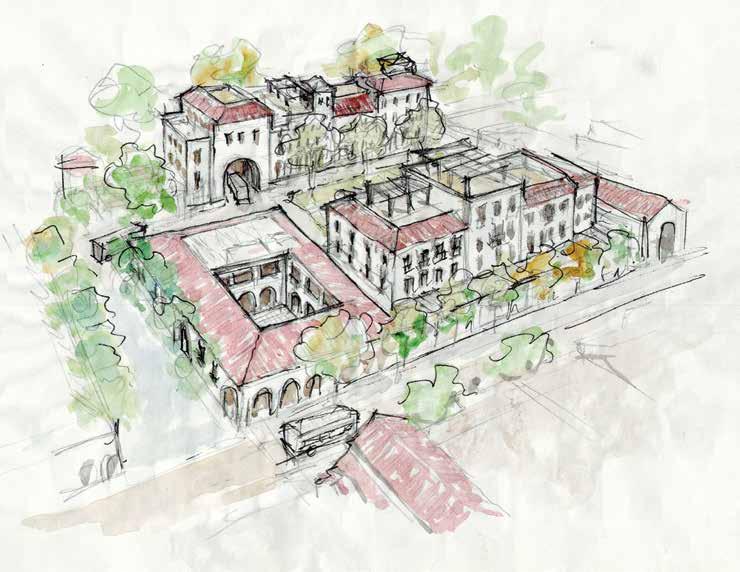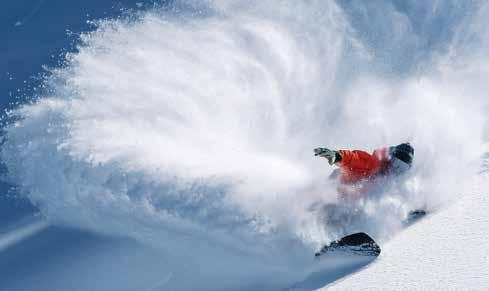The Long Now of Santa Barbara
Novelist Being Audrey Hepburn, Things I Can’t Explain. Creator Clarissa Explains it All and more. Writer for The New Yorker, LARB, National Lampoon, and Saturday Night Live
by Mitchell Kriegman
Pearl Chase Team 7 (Architects: Gabriel Zamora, Anthony Grumbine, Rachel Back, Gordon Brewer. Landscape: Chris Gilliland. Planning: John Moyer) capitalized on the Chapala Transit Hub, wrapping higher density residences around the busy Chapala/Figueroa block
F
ive years from now, Santa Barbara will mark the 100th anniversary of the earthquake of 1925 that killed thirteen people and caused 111 million in damages in today’s dollars. The quake sparked a stunning re-envisioning and rebuilding of the small town of 20,000 people laying the essential foundation of the unique city that is known the world over. That unified vision of red tile roofs and white-washed stucco as manifest in the architectural designs of George Washington Smith, Lutah Riggs, and others championed by Pearl Chase and Bernard Hoffman in the 1920s, has served Santa Barbara exceedingly well for almost a hundred years. Today almost exactly two years after the triple once-in-two-century environmental disasters of drought, fire, and mudslides that struck the county in 2018, killing twenty-three people and causing quite possibly more than a billion dollars in damage, the city now of just under 100,000 is facing a reckoning with a wide host of issues, perhaps none more crippling than a lack of leadership and vision.
A Vision Vacuum
An understanding of the “long now” and how to achieve it is in short supply these days. It requires seeing today in the context of the future,
22 MONTECITO JOURNAL
with a persistent commitment to a long-term vision. That’s the way Pearl Chase thought. If she were here today, what would Pearl Chase do? Where will the vision for the Santa Barbara of the future come from? An investigation into that question – the Once and Future Santa Barbara – begins with another set of architectural designs created by a collective of local architects completed three years ago during a two-week charrette, before the mudslides. The drawings were only marginally discussed in the public at the time, yet they offer a glimpse of a dynamic potential Downtown Santa Barbara; one filled with natural neighborhoods, meandering paseos, green plazas and courtyards, as well as blended residential housing and retail, bringing State Street to life. The drawings evoke a town still true to its reassuring red tiled roofs and stucco walls, yet filled with diverse urban spaces, where something is always happening around the corner, as opposed to the current tedious, thirteen block main street thoroughfare that State Street is today. That enticing alt vision of a Santa Barbara soon fell by the wayside in the necessary focus on the emergency efforts that followed the January mudslides. “It was understandable given the greater, immediate magnitude of what was going on at the time,” remarked
Ellen Bildsten, past president of the American Institute of Architects Santa Barbara and one of the leaders of the charrette. An awareness of the charrette permeated discussions that followed but the drawings were soon forgotten. As Montecito dug out from behind boulders and mud, stores on State Street continued to decline at an ever-alarming rate, leaving buildings empty and lifeless. Pricey studies, city meetings, commissions, and surveys followed, while efforts to create incremental change in permitting and trial initiatives gradually developed. As
pronouncements of a “retail apocalypse” were made, the Funk Zone with its eclectic mix of business types and free-wheeling architectural spaces appealing to millennials near and far thrived, confounding the city norm. Downtowns in surrounding cities like San Luis Obispo and Paso Robles also experienced an uptick. It has become obvious that downtown Santa Barbara’s decline was due to more than increased online shopping. State Street is stuck in time – the 1970s to be precise, when “cruising down the boulevard” and big department stores with two floor escalators meant something. As a thoroughfare it’s useless, the traffic crawls but can’t stop, it’s like driving through a fishbowl. Now, it seems pressures in Santa Barbara have built to the point where a wide array of community groups, stake holders, and businesses are
The 1925 Santa Barbara earthquake killed 13 people and caused millions in damages to downtown
5 – 12 March 2020

















